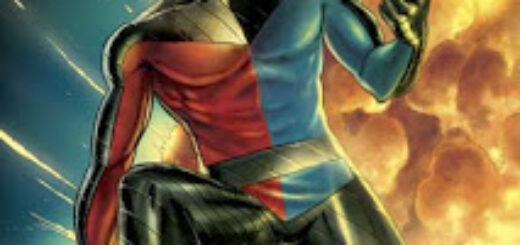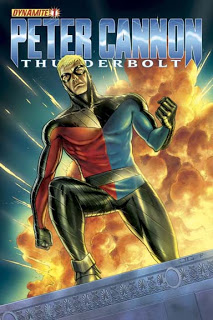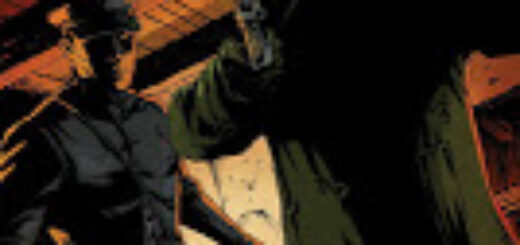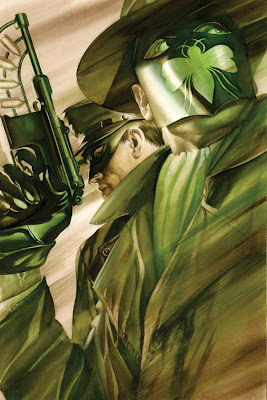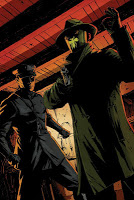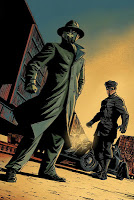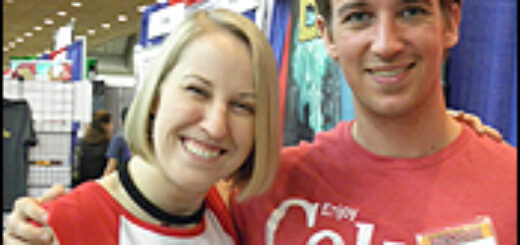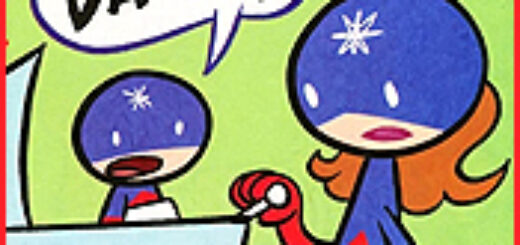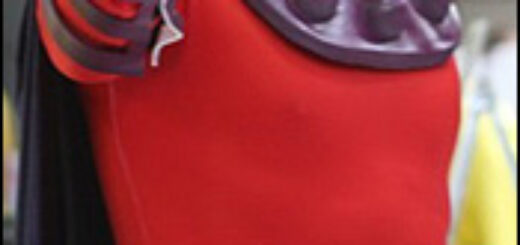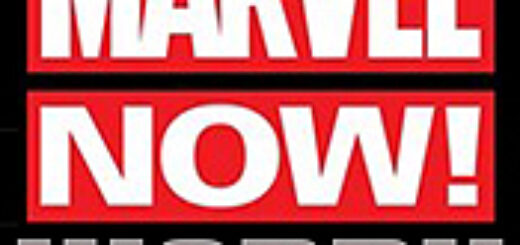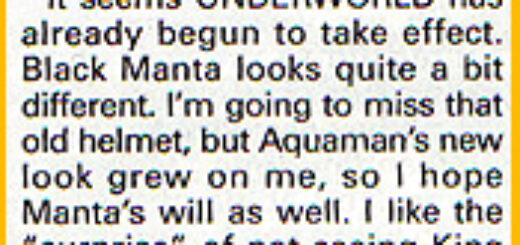Peter Cannon: Thunderbolt #1 Review
Tagged: Mark Waid
MARK WAID TACKLES THE GREEN HORNET AND KATO IN 2013
Award-winning writer, Mark Waid will pen new adventures of the Green Hornet and Kato for Dynamite Entertainment to follow Matt Wagner’s fan-favorite Green Hornet Year One series.
PRESS RELEASE:
Dynamite is proud to announce multiple Eisner and Harvey Award winning writer Mark Waid, will be relaunching the Green Hornet in 2013. Mark Waid is one of the premier writers in the comics industry, known for his critically acclaimed as well as commercial successful books including Kingdom Come, The Flash, Captain America, Daredevil, and Fantastic Four as well as the upcoming The Indestructible Hulk. Green Hornet will also feature covers by Mark Waid’s Eisner and Harvey Award winning Daredevil artist, Paolo Rivera! Look for Green Hornet and Kato in 2013, from Dynamite Entertainment!
“It should come as little surprise that I have an affinity for all costumed crimefighters no matter if their adventures are ‘period pieces’ or not–heroism is heroism regardless of whatever year’s on the calendar,” says writer Mark Waid. “With this Green Hornet project, which I’ve been percolating on for more than ten years, I’m able to meld my love of the Hornet’s legacy with a little bit of Citizen Kane and a lot of Lawrence of Arabia to tell a story never before told–the dark years of the Hornet’s later career and the one mistake he makes that nearly costs him everything.”
“I wasn’t very familiar with The Green Hornet growing up, but I always thought he looked sleek and stylish – I guess I had a soft spot for old-school heroes,” says cover artist Paolo Rivera. “I later discovered that he was designed by H. J. Ward, my favorite painter of all time. The more I learned about Ward, the more I learned about Britt Reid and Kato, including Reid’s familial ties to The Lone Ranger. I can’t wait to render my interpretation of the green team. That, and I miss Mark Waid.”
“Sometimes in life, things happen for a reason. We’ve wanted to work with Mark nearly since Dynamite’s inception. We first approached him about writing a Red Sonja mini-series, but Mark wasn’t familiar with the character and passed. Over the years we’ve approached Mark about various projects, but his schedule did not allow. We’ve always wanted a strong writer to write the original Green Hornet, as Matt Wagner has done a fantastic job on Green Hornet: Year One. And since Green Hornet: Year One, we hadn’t found the right writer for a new series. When Mark’s schedule allowed for us to finally work together, I asked which character(s) he would like to write. Right off the bat, he said the Green Hornet. I said “Yes!”. It was perfect for everyone. It took awhile, and I’m proud to say we’re working with Mark Waid on a Green Hornet series, and it is worth the wait. Sometimes in life, things happen for a reason.” – Nick Barrucci, Dynamite Entertainment President
“LIKE” DYNAMITE’S FACEBOOK PAGE TODAY!!!
Join the conversation on Dynamite Entertainment’s twitter page.
To find a comic shop near you, call 1-888-comicbook or visit www.comicshoplocator.com
For art and more information, please visit: www.dynamite.net
Emily S. Whitten Talks With Reilly Brown
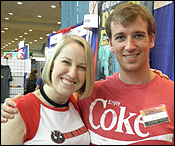 I’ve been a fan of Reilly Brown’s artwork since I first came across it in Marvel’s Cable & Deadpool, and have been following it off and on ever since. There are a lot of artists I like out there, but Reilly is consistently a favorite of mine – his characters’ expressions and the way his drawings capture the energy and emotion of whatever’s happening on the page really appeal to me. I also consider him among the pioneers of the digital comics medium. One of his current projects, Power Play, is a digital comic that was the first effective use of the medium that I had ever seen. To pull from my thoughts when I reviewed the Power Play preview in 2011:
I’ve been a fan of Reilly Brown’s artwork since I first came across it in Marvel’s Cable & Deadpool, and have been following it off and on ever since. There are a lot of artists I like out there, but Reilly is consistently a favorite of mine – his characters’ expressions and the way his drawings capture the energy and emotion of whatever’s happening on the page really appeal to me. I also consider him among the pioneers of the digital comics medium. One of his current projects, Power Play, is a digital comic that was the first effective use of the medium that I had ever seen. To pull from my thoughts when I reviewed the Power Play preview in 2011:
“This is the kind of thing I geek out about, because it excites me to see the potential of the medium being explored to enhance the reading experience. In places it reminds me a bit of the Watchmen stop-animation type video comics they did around the time of the movie, only I never had the patience to watch all of those, since I’d read the book a million times already and they moved too slowly from one frame to the next. But having the ability to read at one’s own pace, and still get the animation-like effects now and again, is fantastic. Being able to see one or two panels at a time, zoomed in or close up, is great. I love the panning from one part of a panel to another, and the fading from full color to monochrome for effect. Having the direction of the screen shifts follow the action is cool; or having the shifts follow the narrative and captions. Also I like how Reilly has the characters in similar poses in a couple of frames, but shifting from one frame to the next gives you the action of a head turn or tilt like in animation.
This is truly the future of how digital comics should be read. I definitely wish I had an iPad so I could experience it in a bigger window, but with only a smartphone, this is hands-down the best way to see digital comics on a hand-held device. For comparison, I downloaded DC Comics New 52 #1 preview and tried reading it on my Droid 2. Now, I know on a computer the usual format is fine; but on a smartphone? It’s fairly unreadable. All the zooming in and panning around necessary just to see one page is a total pain, and not something I have the patience (or eyesight) for. The Power Play layout is infinitely better.”
Given Reilly’s dynamic art and his excellent use of the still-fairly-new digital comics medium, I always consider him one to watch. I’ve also been telling him since something like 2009 that I was going to sit down and interview him one of these days. Finally, at this year’s Baltimore Comic-Con, we made it happen. So here we go!
Emily: So, Reilly, what’s your favorite project that you’ve ever done?
Reilly: My favorite project that I’ve ever worked on is Power Play. I just love doing any creator-owned stuff, especially when I get to sit down and make my own character designs. And not having to feel like the shadows of all of the other decades of awesome artists that have worked on a project before me are looming over me is really freeing. It’s also fun to play around with the digital media and things like that.
Emily: Tell me, what was the genesis of Power Play?
Reilly: It started with me and Kurt Christenson, the writer; since we were both in the same studio at the time, and we’ve been friends for years, one day I said, “You know what, why don’t we do a project together?” and he was like, “Yeah, man, I’d be into it.”
When it started out, we just wanted to do something small, just a quick little simple thing; but as we were spitballing ideas, it turned into this idea that we realized could be really cool if we tried to turn it into something big. The basic idea is that I really wanted to do a story that is based in New York and really uses New York, the real city, as a backdrop. Because so many comics take place in the city but “New York” is just generic buildings in the background or whatever. When I’m walking around the streets, I just see so many cool things – like architectural things, or construction things, or just random things on the street, that are totally normal, but I don’t always think about them when I’m just sitting at my drawing table. And so many of the comics writers don’t even live in New York, so – you know, how do you really make use of a place if you’re not there? I wanted to incorporate New York into a comic.
Emily: How long have you been in New York?
Reilly: I grew up in New Jersey, so I’m right across the river, and I went to school in Virginia but then I moved back after I graduated. So around January 2005 I moved back to New Jersey, with a studio in New York; and I just really wanted to do a story where the writer and I walk around town and plot things out as we go, and just, say, point to a thing, and say, “Okay, the character could jump from that building to that lamppost; and then take a photo reference while we’re there – I actually have photos of most of the backgrounds.
Emily: I didn’t know you actually walk around to plot the stories. That’s pretty cool. So tell me, what’s your favorite hangout or place to go in NYC?
Reilly: There are so many good places to hang out, and it changes all the time. Crocodile Lounge is always a stand-by for me, to go play some skee-ball; and you get a free pizza with every beer. Actually, that’s the bar they go to in the first issue of Power Play; where Mac turns into beer. And…I don’t know, there are too many awesome places to choose from — and half the time, the place is not going to be there in six months.
Emily: That’s true. So who’s you’re favorite character from Power Play, and how does he or she relate to the city?
Reilly: That’s a hard one. I love Gowanus Pete, and the Ice Queen, and Mac…all of the characters are so much fun to draw, and I just feel so close to them.
Emily: Who was the first one you came up with?
Reilly: It was probably either Mac or Gowanus Pete… or the Ice Queen. The studio’s right on the Gowanus Canal, and I remember Kurt and I were having a conversation trying to come up with different characters and their powers as we were leaving the studio and walking to get some lunch. I wanted all of the characters to have kind of goofy origins based on things or places in the city, and just take it to a ridiculous degree; so we were around the Gowanus Canal, which is the nastiest body of water in the country, I mean, it’s horrible. It’s like, multicolored; it’s really just a run-off ditch for a bunch of different waste dumps and things, seriously – look it up. Every now and then you’ll see them testing it to see the different acidity levels and different bacterias and diseases and things people find in there, like they’ll find a dead shark in there, or something like that, or a tiger skull; weird things. So the joke I’ve always had was that if anyone fell in there, they would be horribly mutated – so Kurt and I were walking around talking about different characters and different ideas and powers or personalities, and as we were crossing the Gowanus, there was a really big poster or mural or painting or whatever of the silhouette of an octopus, and Kurt looked at it and said, “Well that’s a character,” and I was like, “Yeah, that’s Gowanus Pete right there.”
Emily: That’s great. You’ve done a really cool digital thing with Power Play – tell me about your digital process and how that all happened; and what your thoughts are on digital comics.
Reilly: The thing that really drove me to do a digital comic was pretty much that no one else was doing it. I saw an area that seemed ripe for comics and for comic artists to play around with, and nobody else seemed to be jumping on it. There are a couple of little webcomics here and there that do stuff; but none that really stood out or that did it for a long-term thing.
Emily: I think we should be making a distinction here; because Marvel and DC and all are doing digital comics, in the sense of putting their stationary paper comics online to be viewed with digital readers; but what I’m thinking of is the way that you’ve manipulated the panels and images with Power Play. So that’s what we’re talking about here.
Reilly: Right; well ComiXology came out, and they were translating all of these Marvel and DC comics, so the typical, mainstream, superhero comics were finding this new digital home through their application. And I was looking at this, thinking, “This is a really cool thing; somebody is going to see this and start making comics designed specifically for ComiXology, or this type of digital format, and they’re going to do it in a way that uses the new digital storytelling techniques.
The thing is, ComiXology did a great job of translating the comic to the iPad, and there are other companies that have tried doing that, but they’ve seemed to trip over the fact that the comics page and the iPad screen, or even the computer screen, aren’t the same shape. Everybody else was stumbling over this, and you had to scroll, or everything was shrunk too small, or you had to zoom in yourself, or there’d be all sorts of problems with it; and ComiXology had found a pretty simple way around that, and it worked great, and it looked great. Yeah, there were a few hoops they had to jump through, but the way they solved those problems; like their guided view thing, you know, where they would actually zoom in on a part of an image that needed to be zoomed in on; and then they would zoom out for the rest of it; or it would pan from one thing to another, and fade from one thing to another, was great. And I thought, “Man, look at all of this stuff they’re pretty much doing by accident at this point; somebody’s going to come around and do this on purpose and it’s going to make an awesome comic.” But nobody was doing it, so then I thought, “Well maybe I could do it. Maybe I’ll be the guy to do that!”
So that’s why we started working on Power Play. I was talking about how we came up with the idea for Power Play; and one of the things we wanted to do was to take advantage of the new mediums. You know, one of the big problems in the entire economy right now is that young people don’t leave their houses or spend money. They’re just on Facebook, downloading things for free, and sharing with their friends, and it’s at the point where if something is not on Facebook, nobody’s going to see it, or at least not as many people as should see it. So we said, “Whatever we do, we want to get it in front of as many people as possible, so let’s come up with a way of doing a really great thing that we can link through Facebook, and everyone can share it; and that takes advantage of that. “ And ComiXology was developed so perfectly for that. So we jumped on that.
Emily: I still point to your comic to show people how this can work. I know there may be a few now, but it’s still not as big as I would expect.
Reilly: You’re right; I’m surprised more people haven’t jumped on it. There are a few others that were first adopters like me, like Alex de Campi and Christine Larsen (Valentine). They actually beat me to the punch; we were already working on Power Play when I saw that come out, and I was like, “Aw, crap, we’re not the first anymore! We’ve really gotta get this thing going!” There’s also David Gallaher and Steve Ellis’s Box 13, which ComiXology actually hired them to make; so it’s really made for their app. And reading that, you really see how their [Steve & Dave’s] thought process is developing on how to use it. How they are learning. At first, it was just as simple as, let’s just make the panels the size or shape of a screen. But then they started seeing more potential. I was in the same building – Steve Ellis’s art studio was just down the hall from mine – so I was working on Power Play while they were working on that, so we’d bounce ideas off of each other. So it was cool to see how some of that stuff ended up playing in their comic.
Most recently, Marvel had their Infinite Comics, which I was happy to be a part of. They have the big AvX [Avengers vs. X-Men] story, and I’d been talking about what I’ve been doing with Power Play to Marvel for awhile, like, “Let me do one of these for you!” I talked to all the editors… Nick Lowe was the one who was really spearheading it over there; or at least when I was talking to them Nick Lowe and Jordan White were the editors that I worked with on that. They’re awesome for seeing that potential and taking a risk, because, you know, Marvel doesn’t often do stuff like that, where they don’t know how it will turn out; and it’s pretty impressive to see a big company like that try to take a risk on something that’s so new. But at the same time I was doing this, Mark Waid was starting his Thrillbent thing, so he was talking all about it. So he wrote the three AvX Infinite installments, and I drew the third one; which was cool. And that was all ComiXology stuff, and it’s all just like how Power Play was done.
Emily: That’s fantastic. I’ll have to look that up, because I haven’t seen it yet. So now, what does the future hold for you?
Reilly: Well I’m not exclusive with Marvel, but I’m currently working on some Scarlet Spider stuff, and we’ll see what happens from there. I’ve still got Power Play going on, and I’ve got some other side projects… I have so many things going on right now!
Emily: It sounds like it! Well Reilly, thanks so much for talking with us , and I look forward to seeing what you come up with next!
…And until then, ComicMix readers, remember to tune in next Tuesday for my interview with Dean Haspiel, and Servo Lectio!
TUESDAY AFTERNOON: Why Does Michael Davis Read Comics?
WEDNESDAY: Mike Gold Attacks Mars Attacks!
Marc Alan Fishman: Comics Are Good For Learnin’
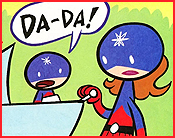 So it came to my attention by way of an amazingly nice lass that some forward thinking teacher-types are slowly coming around the bend. Yup, they are looking toward comic books, those evil things, as potential fodder for their classrooms. Gasp! And, as it would seem, this very nice girl asked me – little old me – to give my two cents on the matter. And because I love killing two birds with one stone, I figured this outta make a great li’l rant to share with you, my adoring public. Of course, I realize now I admitted to the glee I feel when I commit aviaricide. Well, there went my fan-base. Tally ho!
So it came to my attention by way of an amazingly nice lass that some forward thinking teacher-types are slowly coming around the bend. Yup, they are looking toward comic books, those evil things, as potential fodder for their classrooms. Gasp! And, as it would seem, this very nice girl asked me – little old me – to give my two cents on the matter. And because I love killing two birds with one stone, I figured this outta make a great li’l rant to share with you, my adoring public. Of course, I realize now I admitted to the glee I feel when I commit aviaricide. Well, there went my fan-base. Tally ho!
I know back in the olden days, comics were largely seen as kitchy wastes of ink and paper. Kids buried in them were potentially violent sociopaths just waiting to commit crimes of laziness. But by the time I was in school they were starting to be called graphic novels. Thanks in large part to the artsy works of Art Spiegelman, Joe Kuburt, and Will Eisner, the medium as a whole was slowly pulling itself out of the low-bro.
That being said, I was never assigned a graphic novel to read for a class. Nor was I able to select one for independent book reports or the like. Even within the realm of studio art classes I was nixed the ability to cite Alex Ross as a major influence without scoffs. But as Bob Dylan sings, “The times, they are a changin’.”
If I were to suggest opening up a classroom to comics, well, it’s a simple issue – do it. Comics are easily one of the best gateways to literacy I can think of. Truth be told, the first books our parents read us (and I’m reading to my own boy now) are gloriously illustrated. Dr. Seuss, a one-time newspaper comics guy, is just panel borders away from sharing shelf space with Daniel Clowes. In the earliest of classroom settings I’d start with the recognizable. Art Baltazar and Franco’s Tiny Titans is as accessible a comic as I know of. But more than just being kid friendly, the book is funny, bright, and charming. So much so that I was an avid reader of it long before I was even married, let alone a father. And because it uses semi-recognizable super hero sidekicks, it’s easy for kids to relate, and learn to read.
Tiny Titans aside, there’s always Jeff Smith’s tome of toonage, Bone. The long running series blends laughs, mysteries, and adventure. If kids can’t find something to love there? Well, then I’ll eat my hat. Come to think of it, I don’t own hats anymore. Note to self…
Beyond the early readers, the always-tough-to-please nine year olds (perhaps through 13 or 14?) are going to start dividing themselves. Girls have cooties. Boys are messy. The division of the sexes may make many a teacher feel like comic books will degrade into the capes and cowls for the boys and leave nothing for the girls. Nay, I say. Nay! Both the boys and girls can take heed that I myself grew to love comics at this tender age due to the long-running Archie series. And Archie, unlike his more heroic counterparts, seems to have found a way to stay with the times, without diverging into the too-real, too-gritty, or too-angsty. Consider also the Adventures of TinTin. Long before it was a computer-animated movie, it was a comic. A great comic. And don’t we all laugh a bit when we recount the Scrooge McDuck comics of yesteryear? That book was doing Inception long before Chris Nolan was firing up the vomit-comet to film anti-gravity fight scenes.
The real meat and potatoes for me though come right at adolescence. Here, our kids are primed to learn that comics are more than just good fun. The Pulitizer Prize-winning Maus (by the aforementioned Spiegelman), Jew Gangster (by the late and beyond-great Kubert), and A Contract With God (by Will Eisner) all help teach that the medium of comics transcends the super power set. And sure, they all hold quite a bit of Jewish lore to them… so allow me to expand beyond Judaica.
Mike Gold himself turned me on to Stagger Lee by Derek McCulloch and Kings in Disguise by Dan E. Burr. They are both amazing reads. And please, don’t get me wrong – comics at this tender age need not be without a twinge of the supernatural. Watchmen might as well be a high school freshman class in and of itself. Frank Miller’s Sin City and or 300 are far better on page than on screen, and on screen they were both pretty amazing.
And let’s not leave Marvel out of this. Kurt Busiek’s Marvels singlehandedly brought me out of a four year freeze of comic book reading. It’s insightful, and a beautiful take on super heroes from the human perspective. And I’ve little column space left to suggest even more here… Empire by Mark Waid and Barry Kitson, Astro City, Batman: Year One, Runaways and Y: The Last Man all spring to mind. But I digress.
Suffice to say, introducing comics to a literature program shouldn’t be that hard to tackle. The fact is the medium itself makes open discussion far easier to instigate. More work to enjoy than watching a movie, without the scariness of endless pages without something beyond words to look at means less barrier to entry. For those learning to read (or who have trouble with it) comics are a gateway drug to amazing new worlds. For those already well versed in literature, comics offer an endless string of independent authors bringing original takes on the world that combine their plots with art that tends to force us to stop and appreciate. Akin to indie films, comics at any age offer more than the commercial world. Thanks to a bit of knowledge gained at this year’s Harvey Awards (thank you, Ross Ritchie), I leave on this thought:
“The French codified it well: they call it “The Ninth Art.” The first is architecture, the second sculpture. The third painting, the fourth dance, then there’s music, poetry, cinema, and television. And ninth is comic books.”
Now, the question is: if it is indeed the ninth art of our world, comics should not be considered for the classroom. They should be compulsory.
SUNDAY: John Ostrander
Mike Gold: The Baltimore Fun
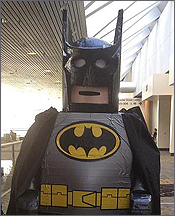 I like comic book conventions, although I’ve been pretty hard on them lately. These days most conventions have little to do with comic books. They have a lot to do with pop culture and celebrities and movies and autographs and promotion, but over the past decade or two comic books have become the ugly stepchildren within their own temples.
I like comic book conventions, although I’ve been pretty hard on them lately. These days most conventions have little to do with comic books. They have a lot to do with pop culture and celebrities and movies and autographs and promotion, but over the past decade or two comic books have become the ugly stepchildren within their own temples.
Except for a handful. Mid-Ohio Con has been consumed by the dreaded Wizard ogre; that one used to be a favorite. HeroesCon in North Carolina is high on my list of the exceptional; I wish I could get there each year. There are plenty of great small shows, usually held in hotels and attracting people from about a 200 mile radius, if the weather is agreeable. And, as I’ve incessantly proselytized to the annoyance of thousands, my absolute favorite: the Baltimore Comic-Con.
First and foremost, the Baltimore Comic-Con is about comic books. The panels are about comic books. The exhibitors are about comic books. The awards ceremony is about comic books. In short, it is a comic book convention.
Second, it’s only two days: Saturday and Sunday. The burnout rate is low and people tend not to leave as early on Sundays. You can get as much done in those two days as you can elsewhere in three… or four. Third, the staff is well-trained, efficient, and so damn polite if you’re from New York your skin just might peel off in strips.
I’m happy to say I’ve got a hell of a lot of friends who go there. It’s one of the few shows Timothy Truman attends. Mark and Carol Wheatley both put me up and put up with me year after year; my daughter and ComicMix comrade Adriane Nash gets to stay in Mark’s breathtaking library and studio. Marc Hempel joins us at the Insight Studios booth. Great folks like Gene Ha, Brian Bolland, Amy Chu, Andrew Pepoy, Denis Kitchen, Jack C. Harris, Walter and Louise Simonson, Joe Rubenstein, Larry Hama, Matt Wagner, John K. Snyder III … we don’t have the bandwidth to name a tenth of the people I hang out with at the show. Even the (fairly) recently liberated Paul Levitz showed up as a freelancer.
Better still, the ambiance of the Baltimore Comic-Con allows me to make new friends, something that’s almost impossible to do at the largest shows like San Diego, New York, and Chicago. This year I was exceptionally lucky, spending memorable time with Phil LaMarr and Ross Richie.
ComicMix was there in full-force: Vinnie Bartilucci, Glenn Hauman, the aforementioned Adriane Nash, Emily S. Whitten, and the non-alphabetical Marc Alan Fishman – who was there with the rest of the Unshaven Comics crew, Matt Wright, and Kyle Gnepper, where they managed to sell out of their excellent indy comic, Samurnauts.
Probably the highlight of the Baltimore show each year is the Harvey Awards dinner, and this year was no exception. Phil LaMarr served as master of ceremonies, keeping the three and one-half hour show moving while keeping the audience in stiches, Ross Richie delivered an inspiring keynote address, and as usual Paul McSpadden did his usual amazing job coordinating the whole event.
The Hero Initiative honored Joe Kubert with its Humanitarian of the Year award – a decision made before Joe’s passing last month – and Dr. Kevin Brogan delivered a moving tribute to the late cartoonist and educator. As it turns out, Joe left us one more graphic novel. Their annual Lifetime Achievement Award went to John Romita Jr., in a presentation made by the team of Stan Lee and John Romita Sr.
I particularly enjoyed seeing Marc, Kyle and Matt there for the first time – being sequestered in that room with most of the above-mentioned folks as well as with Stan Lee, John Romita Sr. and Jr., Mark Waid and so many others seemed like a heady experience for our pals, who, I think it’s safe to say, were in fanboy heaven. Pretty damn cool. I’m proud to say our own Glenn Hauman helped in the IT end of things, and ComicMix joined Insight Studios, DC Entertainment, Boom!, Comixology, Richmond Comix and Games, ComicWow!, Painted Visions, Bloop, Captain Blue Hen, Cards Comics and Collectibles, and Geppi’s Entertainment Museum as sponsors.
And I managed to sign up a new columnist for this site. I mentioned the name above somewhere (good hunting), and this person will start out as soon as we iron out scheduling issues and the usual start-up stuff. I’m very excited about this, and you will be too when you read this person’s stuff.
We also went apeshit covering the cosplay scene. Adriane posted about 100,000 pictures on our ComicMix Facebook page, all to the obvious enjoyment of the masses. We’ll be expanding our cosplay coverage considerably, while at the same time polishing our alliteration.
On behalf of the whole ComicMix crew, I want to deeply thank Marc Nathan and Brad Tree for once again putting on the best show in comics, and to thank my dearest of friends Mark and Carol Wheatley for being our personal sponsors. We-all had a great time!
THURSDAY: Dennis O’Neil
Review – Peter Cannon, Thunderbolt
Peter Cannon Thunderbolt is back and Dynamite delivers it with style with a new number one that came out this week.
Dynamite has done a great job with taking old pulp concepts like Lord Of The Jungle and bringing them back with a new look and style, yet remaining true to the concept. Peter Cannon is no exception.
Issue one opens with the Thunderbolt battling a dragon. Experiments with nuclear testing caused a dragon to appear in the sky. It was subdued (for the moment) by the Thunderbolt and led countries to talks about nuclear disarmament. We flash forward two years later and Peter is looking miserable as he prepares to be interviewed on another talk show. The thunderbolt identity is known to the world. Peter did this to stop people from being hounded by reporters – now finds himself facing the challenges of celebrity and fame. Things didn’t go quite as expected and Peter seems to be searching for a way to overcome the distractions in his life.
Along the way, new and old acquaintances to the previous thunderbolt series make their appearances, foreshadowing future issues to come. The conclusion is unexpected and in a good way. Steve Darnall and Alex Ross managed to capture a lot of the qualities that made the character so intriguing, and manage to build an intriguing mystery to keep you coming back for more. Jonathan Lau’s Thunderbolt is impressive, but I think my favorite panel in the issue is peter, alone in his dressing, head down and drowned in shadow. In conveyed his personal happiness better than anything else in the whole issue. It’s the little storytelling things that make or break a good book and that little panel was a nice touch. A credit should also be shared with Vinicius Andrade for that as well.
Beyond the main story, Mark Waid introduces Pete Morisi Thunderbolt story never before published. A little bit of that Charlton fanboy in me squeed at reading this retelling of Peter Cannon’s origin. Who better to tell it then Morisi himself?
Originally, this story was going to be published for DC Comics in the Secret Origin’s anthology that Mark Waid was editing at the time. Due to unforeseen circumstances, the story never was published until now. In it you meet Peter Cannon, and get a great re-telling of his origin. You see him train and master the ancient scrolls to become the Thunderbolt. The hooded one, the man studying the scrolls before Peter was chosen for them, also appears and begins to become a thorn in Peter’s life, from his trials to the main plot of the first story.
Using his telepathy, the hooded one manipulates Lucifer Barnes into hatching a dinosaur egg and sets it loose in the city. As the thunderbolt, Cannon foils the plot and vows never ever to be that man again…until next time.
The final thing in here that’s kind of neat is the essay in the back written by Steve Darnall called Pete’s Dragon, which talks about the influences for the main story in the book which is a fascinating read.
You’d be very hard pressed to find a book this week worth the money paid for then with this. Two comic stories – including a Peter Morisi comic, a promising first issue and one of the amazing four covers for the book, all in all a great comic worth reading.
Marc Alan Fishman: Wizard World Redemption
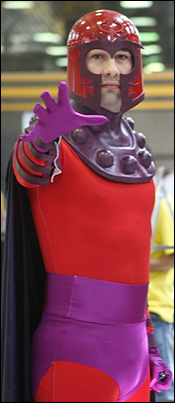 Hello, everyone! After last week, I figured it’d only be fair that I give Wizard World a little hand up, since I was so quick to toss them into the gutter. Suffice to say I saw a ton of responses via Facebook, Twitter, etc. in support of my disappointing feelings at this past Wizard World Chicago. So, with all eyes from their ivory tower now squarely pointed at me*, I shall make an epic journey for Wizard, giving them the laundry list of things I’d like to see them do to reclaim their former convention glory.
Hello, everyone! After last week, I figured it’d only be fair that I give Wizard World a little hand up, since I was so quick to toss them into the gutter. Suffice to say I saw a ton of responses via Facebook, Twitter, etc. in support of my disappointing feelings at this past Wizard World Chicago. So, with all eyes from their ivory tower now squarely pointed at me*, I shall make an epic journey for Wizard, giving them the laundry list of things I’d like to see them do to reclaim their former convention glory.
Remember what started this whole shebang – comic books. Just because you can’t lay claim to the publishing giants does not mean with some delicate planning, you can’t land the amazing creators behind said publishers. Suffice to say, if you bring them, the fans will come. People love Marvel and DC. But they don’t come to the convention just because there’s a chance to see DC Direct action figures and snag some Marvel posters. More often than not? The mainstay of your crowd – the real comic fans – want a chance to meet the creators behind their favorite book. Whatever Wizard did to shun so many artists and writers? Well, it’s time to send out some apologetic gift baskets, and comp the way for the names that will draw in the most people.
And if you should be so lucky to entice a gaggle of cool creators, the next step is simple: plan a convention that celebrates the medium through intelligent discussion and good old-fashioned fun. What this means? Programming. Even in the larger convention halls, your crowd can peruse the show floor in about two hours, if they take it slow. This means that there is time in every show-goers’ schedule to enjoy something more than just spending their money.
In my youth, I recall amazingly fun panels: the Silver Age Trivia Contest, hosted by Mark Waid, the CBLDF Sketch-off, where top names like Jim Lee and Phil Hester jammed on audience suggestions for charity, as well as countless “how-to” panels where small gatherings of 50 or so fans got live demonstrations on everything from digital inking to script writing. At their core, the conventions are here to celebrate comics, not (just) corral all our cash.
Next up on the list? The non-comic stuff. Hey, I freely admit that these shows have grown to encapsulate all of Nerdtopia. And it’s cool if the show plays well with others. Comic geeks are also Trekkies, Jedis, Whovians, Vampires, and Otaku. So bring on the D-List Sci-Fi Channel celebutaunts. Bring on the retired WWE wrestlers. Create a dais of former Starfleet Captains and Wookies. Just don’t make them the sole reason to come. And better yet? Find a way to reduce the gouging. No need to pay for a show floor ticket, if you’re only there for some pictures. In the past, there was a nice area off the main floor where photo ops and autograph seekers could assemble. Do it again and you can bring back something all good shows have… a laid back traffic flow, instead of a jam of fanny packs and unwashed masses.
The last bit I’d like to touch on is something I yearn for: the promotion of the little guy. For a company like mine, these conventions are the single best way for us to gain a following. We sell books, hard, and do our best to connect to every fan that walks past our table and makes eye contact. With just a little help from show promoters (ahem, Wizard World…) we “indie guys” could have access to the fans en masse. And that could make all the difference in the world. Back when Wizard was huge, tickets came with a grab bag of materials. Offer the opportunity for indie creators to make samplers to place in these bags. Offer up panels to unknowns, who can help lead discussions, debates, tutorials, and demos. Con attendees interested in the content alone might then be converted into legit fans.
In short, Wizard World is well within the grasp of greatness. A few apologies, a few comps, and a few good planners could help take their show from the doldrums their in right now, and slowly rebuild them to be what they once were. The first step though is to admit there’s a problem. As the industry slowly crawls towards the advent of creator-owned content, the convention circuit will quickly become the single best way to connect fans to the industry. Don’t lose sight of that just because you can nab Sookie for a few autographs. We’re the reason these shows started, and dag nabbit, we’re the ones who can make them great again.
* I’m safely assuming that Wizard scours the net for mentions of their cons, and have no doubt flagged me as a ne’er-do-well on their hit list.
SUNDAY: John Ostrander
Marc Alan Fishman: Marvel Now and Later
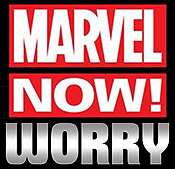 Sorry for my absence last week, loyal readers. It would seem something had to break in my fragile world, and this was the first thing closest to the exit ramp. Luckily for me you all had more important things to do on a Saturday morning than read my rants and raves. Right? You didn’t? You mean to tell me you’ve been sitting there, at your desk, for a whole week… awaiting my article? Jeez. I’m sorry. Let me make it up to you. Let’s start off with something really inflammatory to get back into the thick of it, shall we?
Sorry for my absence last week, loyal readers. It would seem something had to break in my fragile world, and this was the first thing closest to the exit ramp. Luckily for me you all had more important things to do on a Saturday morning than read my rants and raves. Right? You didn’t? You mean to tell me you’ve been sitting there, at your desk, for a whole week… awaiting my article? Jeez. I’m sorry. Let me make it up to you. Let’s start off with something really inflammatory to get back into the thick of it, shall we?
Marvel Now is what I’d wished DC would have done with their New 52.
Marvel comes right out of the gate with the smartest roll-out plan I’ve seen in a while: A sensible one or two new books out every week, over the course of a few months. DC’s “throw everything at the fan, and watch the sales spike and recede” did exactly that. Marvel Now (boy, that’s gonna get annoying) sidesteps the idea that fans are willing to try everything all at once, in lieu of a doing it a few at a time. I’m a marketing man by trade. This screams of “listening to the target audience” and “lowering the barrier to entry” for those less willing to hop aboard. In human-speak? Someone at Marvel realized fans aren’t made of money. They are more willing to start a new series at #1, and toss it into their weekly rotation a little at a time, rather than dump their entire paychecks out for the opportunity to “catch up” to a continuity that wasn’t quite rebooted, wasn’t quite reset, and wasn’t quite defined in the slightest.
Marvel also has taken it upon themselves to shake up some major players on major books, after successful long-term runs had been accomplished. Where DC has been quick to play musical chairs before some writers grew their sea-legs for a particular title, the House of Mouse once again played it cool. Let Bendis play in the Avengers sandbox until he’s run out of awesome things to do. Then let Fraction do the same with Iron Man. Then put Waid (who is still rocket hot after relaunching Daredevil back into our hearts) onto a book, The “Insert-Adjective-Here” Hulk, that frankly I’m sure no one has cared about since Jeph Loeb murdered it in the early aughts.
In the art department, fan favorite John Cassaday gets to give The Avengers a nod, which I hope is as good or better than his work on the Astonishing X-Men. The always tried-and-true Mark Bagely will lend his hand at Fantastic Four, which should loosen the book up from its present look and feel. And over in the Four’s sister (or really… daughter?) book, FF, none other than Mike Alred is slated to put pencil to page. The last time I believe he was around MarvelLand, we got X-Statics, which was X-cellent. Sorry, had to go there.
And how about the overall plan? Axel “Not Danny D” Alonso made it pretty clear that the books that are working well now will have no plan for resets. This means fans of Daredevil, the Punisher, X-Factor and the like won’t have to fear an immediate exit strategy and creative retreat from their favorite books. This is of course (to me, at least) a direct wink and a butt slap to the boys with the new oddly shaped logo.
DC was glad to let its entire line of books stink up the joint for the last three months they were around prior to the New 52 debut. Never in my 20+ years reading comics had I felt more books “phoning it in” then at that time. As a 20+ DC book subscriber? It rubbed me the wrong way. Hard. Here, Marvel seems to realize the old adage holds true; if it ain’t broke don’t fix it.
Generally we know this is the point where I play devil’s advocate. And I see by the folding chair in your outstretched arms, ready to strike me where I type, I’d better get on with the “Howevers…” or else. Now, Marvel Now is just an on-paper-plan at this point. Even with that said, it’s hard not to notice a few things that reek of desperation. I love Brian Posehn. I do. But does anyone here honestly wish to place a wager on how long his run on Deadpool will last?
And just how many Avengers titles are they releasing? 20? 30? We get it, the movie made a kajillion-billion Disney dollars… but someone somewhere had to wave a white flag. As it stands I still contend that the over saturation of books with the popular characters just clutters up racks with an ultimately less-than-the-best product. All this, and somehow, the X-books still all sound ludicrously horrendous, Bendis or not. The idea that “silver age” X-kids land in the present, and get to play the “Oooh-how-the-world-changed-card” to me is choking hard on the gimmick bone. Be sure to take a shot every time NewOld Jean Grey asks “what’s an iPod?”
See? I’m not just shilling for Marvel, unless they wanna send me a check. In that case, I’ll make myself “AR” compatible in a heartbeat. In the mean time, my opinion stands: Marvel Now appears to be better thought-out, with a smarter release schedule, and an ideology that holds on to the notion that quality beats quantity every single time. Mark my words, kiddos. Marvel Now is gonna pants DC, and in the scramble expect DC to fire back with 17 epic all-title consuming crossovers.
Did you mark that down? Good.
SUNDAY: John Ostrander
SDCC 2012: Eisner Award Winners 2012
An updated and corrected list — congrats to all the winners.
Best Short Story “The Seventh,” by Darwyn Cooke, in Richard Stark’s Parker: The Martini Edition(IDW)
Best Single Issue (or One-Shot) Daredevil #7, by Mark Waid, Paolo Rivera, and Joe Rivera (Marvel)
Best Continuing Series Daredevil, by Mark Waid, Marcos Martin, Paolo Rivera, and Joe Rivera (Marvel)
Best Limited Series Criminal: The Last of the Innocent, by Ed Brubaker and Sean Phillips (Marvel Icon)
Best Publication for Early Readers (up to age 7) Dragon Puncher Island, by James Kochalka (Top Shelf)
Best Publication for Kids (ages 8–12) Snarked, by Roger Langridge (kaboom!)
Best Publication for Young Adults (Ages 12–17) Anya’s Ghost, by Vera Brosgol (First Second)
Best Anthology Dark Horse Presents, edited by Mike Richardson (Dark Horse)
Best Humor Publication Milk & Cheese: Dairy Products Gone Bad, by Evan Dorkin (Dark Horse Books)
Best Digital Comic Battlepug, by Mike Norton, www.battlepug.com
Best Reality-Based Work Green River Killer: A True Detective Story, by Jeff Jensen and Jonathan Case (Dark Horse Books)
Best Graphic Album – New Jim Hensons Tale of Sand, adapted by Ramón K. Pérez (Archaia)
Best Graphic Album – Reprint Richard Stark’s Parker: The Martini Edition, by Darwyn Cooke (IDW)
Best Archival Collection/Project – Comic Strips Walt Disney’s Mickey Mouse vols. 1-2, by Floyd Gottfredson, edited by David Gerstein and Gary Groth (Fantagraphics)
Best Archival Collection/Project – Comic Books Walt Simonson’s The Mighty Thor Artist’s Edition (IDW)
Best U.S. Edition of International Material The Manara Library, vol. 1: Indian Summer and Other Stories, by Milo Manara with Hugo Pratt (Dark Horse Books)
Best U.S. Edition of International Material – Asia Onward Towards Our Noble Deaths, by Shigeru Mizuki (Drawn & Quarterly)
Best Writer Mark Waid, Irredeemable, Incorruptible (BOOM!); Daredevil (Marvel)
Best Writer/Artist Craig Thompson, Habibi (Pantheon)
Best Penciller/Inker or Penciller/Inker Team Ramón K. Pérez, Jim Henson’s Tale of Sand (Archaia)
Best Cover Artist
Francesco Francavilla, Black Panther (Marvel); Lone Ranger, Lone Ranger/Zorro, Dark Shadows, Warlord of Mars (Dynamite); Archie Meets
Kiss (Archie)
Best Coloring Laura Allred, iZombie (Vertigo/DC); Madman All-New Giant-Size Super-Ginchy Special (Image)
Best Lettering Stan Sakai, Usagi Yojimbo (Dark Horse)
Best Comics-Related Journalism The Comics Reporter, produced by Tom Spurgeon, www.comicsreporter.com
Best Educational/Academic Work (tie)
Cartooning: Philosophy & Practice, by Ivan Brunetti (Yale University Press)
Hand of Fire: The Comics Art of Jack Kirby, by Charles Hatfield (University Press of Mississippi)
Best Comics-Related Book MetaMaus, by Art Spiegelman (Pantheon)
Best Publication Design Jim Henson’s Tale of Sand, designed by Eric Skillman (Archaia)
Hall of Fame
Judges’ Choices: Rudolf Dirks, Harry Lucey
Bill Blackbeard, Richard Corben, Katsuhiro Otomo, Gilbert Shelton
Russ Manning Promising Newcomer Award: Tyler Crook
Bob Clampett Humanitarian Award: Morrie Turner
Bill Finger Excellence in Comic Book Writing Award: Frank Doyle, Steve Skeates
Will Eisner Spirit of Comics Retailer Award: Akira Comics, Madrid, Spain – Jesus Marugan Escobar and The Dragon, Guelph, ON, Canada – Jennifer Haines
Emily S. Whitten: Getting Started in the Comics Industry
 I love comics. I love reading them, thinking about them, discussing them, and even critiquing them. I also love writing them, something I’ve discovered in the last couple of years as I started writing a series of webcomics about characters in upcoming comic book-related movies, which were then published on movie news websites like MTV Splash Page and ReelzChannel. Since that time, I’ve realized that I’d really like to keep writing comics, including, hopefully someday soon, full issues for a major company, to be seen by all the worrrrrrld [insert maniacal laugh here].
I love comics. I love reading them, thinking about them, discussing them, and even critiquing them. I also love writing them, something I’ve discovered in the last couple of years as I started writing a series of webcomics about characters in upcoming comic book-related movies, which were then published on movie news websites like MTV Splash Page and ReelzChannel. Since that time, I’ve realized that I’d really like to keep writing comics, including, hopefully someday soon, full issues for a major company, to be seen by all the worrrrrrld [insert maniacal laugh here].
That may seem like a big leap, but it could happen. After all, most of the people who are or have been involved in professional comics started out just as I did: as ridiculously huge fans of the medium and the characters and stories. I mean, sure, maybe a few here or there got pulled into a job and then discovered they liked it, but for the most part, the people making comics do it because they were fans who, basically, landed their dream jobs through expressing their love of or thoughts on comics.
There are some great public examples of this amongst the current Big Names in comics. They include Geoff Johns, who wrote in to DC Comics as a kid with suggestions for the Superboy storyline. There’s also Kevin Smith, whose lifelong comics fandom landed him a number of roles in comics-writing after he’d already made a name for himself with movies (and he also owns Jay and Silent Bob’s Secret Stash, the first comic book store I ever went to, being a Jersey gal). There’s also Gail Simone, who came to the attention of comics publishers through her website Women in Refrigerators, which critiqued the treatment of female characters in comics, and has since written a weekly column on Comic Book Resources and a lot of great comics about both male and female characters, including well-received stints on the all-female group comic Birds of Prey. (I mention this comic in particular because I think it’s great that after Simone expressed her opinion on a certain issue in comics, she had the opportunity to address that issue by writing a number of female characters.) And let’s not forget Mark Waid, whose studio tour on Comic Book Resources reveals just how much of a fan collector he is, as well as giving us this quote about a three-page sequence from Flash #0 that hangs on his wall: “[it’s] the scene where the adult Wally West meets his ten-year-old self and tells the boy that no matter how rotten his young life seems or how hard the days are to get through, when he grows up, every wish he’s ever wished for will come true. It’s hands-down my favorite sequence I have ever written because – and I say this in all sincerity – I often dream about being able to travel back in time and tell young Mark Waid that same thing.”
Aw.
Of course, compared to these greats and all of their former-fan-now-professional companions, including my esteemed fellow columnists at ComicMix, I wouldn’t say I’ve had too much of a “career in comics” to date. But like, I suspect, at least a few big names today, I have gone from being “just a fan” to being much closer to where I’d like to be in the industry, and have high hopes of continuing along that trajectory in the future. I know that a lot of other fans have similar hopes. So I thought I’d take a couple of minutes to look back at my own experience with comics so far and see how it’s progressed.
As a kid I hadn’t read many comics, and didn’t even know there were such things as “comic book stores” devoted to (gasp) just that medium. There were a few comics in the house that belonged to my oldest sister – the ones I remember being some old collections of Archie and some individual issues of Richie Rich – and I did read those few books countless times, and remember being enamored of both the funny and entertaining stories and the way the illustrations complimented and enhanced them. But I didn’t lack for reading materials, with an English teacher for a mom and two older sisters who loved books, so I never went looking for more comics.
Television, however, was a different matter. You didn’t have to go out and find television shows – they came to you! So I grew up on a healthy mix of cartoons like Teenage Mutant Ninja Turtles, ThunderCats, X-Men: The Animated Series (I still love the theme song!), DuckTales and Darkwing Duck, Batman: The Animated Series, and countless others, most of which either started as or ran concurrently with comic books (although I didn’t know it at the time). I also, thanks to my dad, got a healthy dose from an early age of adventure and comics-related shows and movies he loved, including Sky King, The Lone Ranger, The Green Hornet, and the Christopher Reeve Superman movies. Fast forward a few years, and I was addicted to Lois and Clark: The New Adventures of Superman (and even later, I got hooked on Smallville. Apparently I can’t resist on-screen Clark Kent). So comics have always been a part of my life, and I’ve always been a fan, but I didn’t realize it.
In 2008, that all changed. Thanks to an ex who suggested we go to the local comic book store for Free Comic Book Day, I started getting interested in collecting paper comics. On that fateful day he recommended a character that “I think you’ll like,” i.e. Deadpool; and after flipping through a couple of issues, I was completely hooked. In the following month I acquired and read all the Deadpool books I could find (as well as a slew of other comics, both new and old), and, in a joking conversation with the ex in which I was pretending to answer questions as Deadpool, I think I said something like, “wouldn’t it be funny if Deadpool was online answering questions?” and he said, “You should totally do that,” and thus, the first entry of Ask Deadpool was born. I made up the first few questions myself; and by the next day, people were writing in. I’ve now been regularly answering questions online as Deadpool for four years.
I’ve never had much of an interest in writing fanfiction generally, but with comics, it feels a little different. In a strange way, the comics industry could be looked at as the ultimate repository for quality fanfic (except that as it’s published, it becomes canon). There are so many professionals that got their start playing in sandboxes that were built by previous professionals that writing a comic book character non-professionally feels less like fanfic and more like practicing to join the fun. Sure, my Ask Deadpool writing is still fanfic (until I take over Deadpool at Marvel and write it for the next 20 years, mwahahaaaaa), but it’s different than someone writing about a closed universe such as, say, the Harry Potter series. Not only is writing comics fanfic a great way to practice writing previously published characters’ voices, but there’s actually the chance that all that practice might someday be put to use, professionally.
And there’s also the chance that in writing about something you love, you will accidentally become known as a gigantic Deadpool fan to everyone you know and many people you don’t, which will result in a friend getting a cool Deadpool print signed to you by one of the best inkers in the business (hey-oh, Nathan Massengill!), and you will be so excited about it that you will get it framed, and send a thank you email and photo of the framed print to the inker, and subsequently become friends with the inker, who incidentally convinces you to go to a comic con and introduces you to a bunch of other cool people in comics, and soon other fans and all these people who actually work in comics will know you as the biggest Deadpool fan ever, and this turns out to be a pretty good thing.
Because then you will turn out to be “the most passionate Deadpool fan” that a movie news site has encountered, and will be asked to write a fan article about Deadpool for them, at the same time that you just so happened to have started writing comic strip scripts using Deadpool and other characters to commentate on current pop-culture news, and have found another fan who’s a great artist and has agreed to draw the comics, and it turns out that you’ve already written a script that exactly fits the topic of the article. And the news site likes it, and want to see more.
That’s how I ended up having webcomics published on popular movie news websites. (Although it’s also important to know your own value and not be afraid to pitch something. My Avengers three-part series ran on MTV Splash Page because I actually pitched it to the editor, rather than him finding me.) The same passion for comics and network of people and happenstances has also led to me meeting the folks here at ComicMix and being invited to write a weekly column; and to me meeting another writer who has already had several comic scripts published professionally, and with whom I am now plotting out the greatest comic series ever created (well we think so, anyway). And although I can’t predict the future, I have high hopes that for me, it will hold an abundance of work in comics.
The interesting thing here is, until recently I didn’t really sit down and think to myself, “hey, maybe I could actually write comics. Like, professionally.” Instead, I was just having fun with something I enjoy, and expressing a passion for characters and a medium I’ve come to love. As it turns out (I think, and evidence suggests), this is a pretty good way to get started in comics, and the more I think about what I’d like to write in comics, the more ideas I have. Along with the greatest comic series ever created, I’d love to write Deadpool for Marvel someday (after much more practice, perhaps!) and I’ve got a Superman story in my head that I think would knock people’s socks off. And that’s just what’s percolating in my brain right now. But really, whatever happens in my future, I’m overjoyed that I am where I am today, writing about a medium I love and interacting with people who keep me inspired, and plan to continue to write columns, and webcomics, and anything else people will let me write professionally, for as long as I can. And maybe, if you’re a passionate fan like me, you can do that too! Servo Lectio!
Wednesday Morning: Mike Gold Covers Covers

